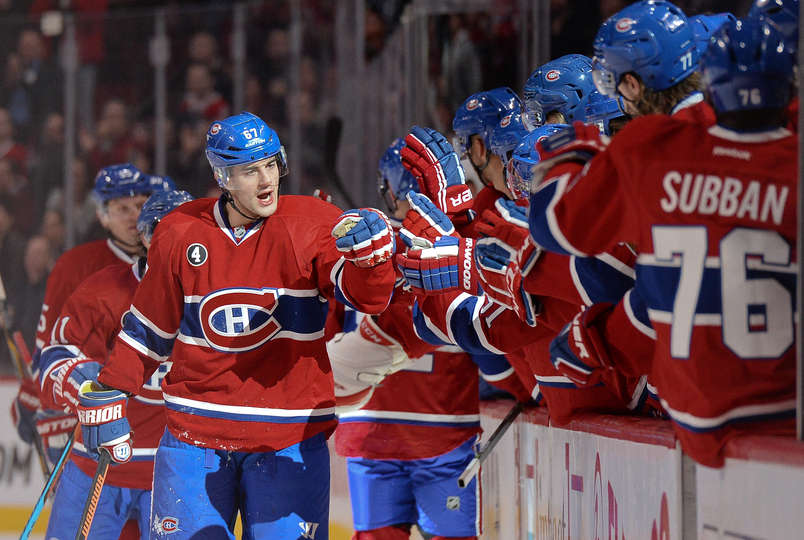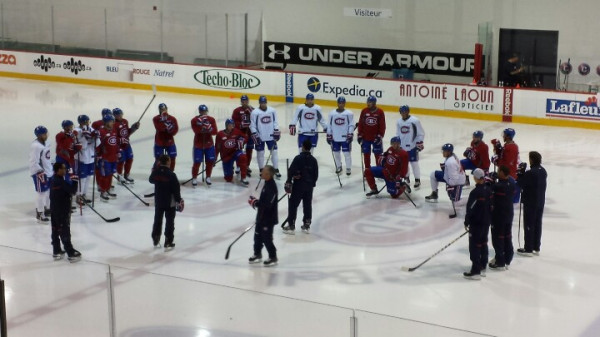by Shannon Penfound, Staff Writer and Event Coordinator, All Habs Hockey Magazine

WINNIPEG, MB. — Group dynamics play a key role in a team’s on-ice success. Positive team-building techniques, for example, are employed regularly by coaching staff in order to improve team communication and camaraderie, in hopes that it translates into the arena. Franke Selke, general manager of the Montreal Canadiens from 1946-1964, believed in the importance of teamwork and its relation to success in the league,
I wanted my players to adapt a shared perspective, rather than an individual one. Personal expectations, attitudes, and motives had to become team expectations, team attitudes, and team motives1.
This season, Habs fans have witnessed multiple line adjustments, often with mixed results. With Michel Therrien and the coaching staff making line changes so often, how does this affect the players and the group dynamics that are built on the ice?

Max Pacioretty has been centred by three Habs so far this season: David Desharnais, Alex Galchenyuk, and most recently, Tomas Plekanec. Plekanec has also seen his fair share of wingers this season, as Therrien continues to search for lines that ‘produce.’ While the majority of these players have known one another and played on the same team as one another for a minimum of at least one season, constant line changes can still affect the quality of cohesiveness on the ice.
Interestingly, studies looking at baseball and soccer teams found that teams with minimal line changes actually performed better in game situations than the teams whose lines changed constantly throughout a season1. Without the stability of consistent line mates, players can struggle to build a relationship that translates onto the ice, which can lead to various issues including offensive or defensive breakdowns.
So why does Therrien continue to change his lines around? It seems as though Michel expects instant chemistry amongst teammates, and when that does not happen, we see further adjustments. In fact, as many Habs fans know, Therrien is even known to adjust lines regularly during game situations. Hoping for instant chemistry amongst line mates can lead to such unrealistic expectations. And yet, Therrien appears to believe in the importance of teamwork and working with his players to secure that positive team dynamic.
“I believe in teamwork and communication with management and coaching staff and with players. These days, there’s something I really, truly understand: players like to communicate. They need to know what you’re feeling and what’s your plan…I coach for my players, for my team, for my bosses — here, for Geoff Molson and Marc Bergevin. That’s always been my philosophy. I’ve never coached for myself. Never2.”
Recently, Habs fans were upset when Galchenyuk, who had been centering Pacioretty, was moved back to LW. During an interview, Therrien explained that he and Galchenyuk sat down and discussed where the young star felt more at ease. According to Therrien, Galchenyuk said on the wing. While I can’t attest to the validity of this statement, if this event truly did take place, then good on Therrien for listening to his players. Though as many of us suspect, this may not have been the case.
Canadiens players have turned into predicting line combinations into a bit of a sport themselves. After recent changes in practice, Pacioretty spoke to TSN’s John Lu saying, “Gally texted me last night, he said ‘You think there’s a change tomorrow?’ Normally we joke around, maybe put a couple dollars on it, predict what the lines will be. We both had the same idea.”
The lingering question is simply: will we continue to see Therrien move players around too quickly when he feels the line has gotten ‘stale?’ In a team sport, group dynamics are key to success. Interrupting the building of these dynamics may be part of the puzzle that continues to be Montreal’s lack of offense this season. The Habs are currently sitting at 23rd in the league with 118 goals in 45 GP.
As always, want to know what you think. Are line adjustments part of the solution or the problem?
1. Weinberg, R.S., & Gould, D. (2011). Foundations of Sport and Exercise Psychology. (5th). Champaign,IL: Human Kinetics.
2. Stubbs, D. (2012, September 11). Chapter II: older, wiser, and greyer.








![Prospect Report: Habs Development Camp Testing [GALLERY]](https://habshockeyreport.com/wp-content/uploads/2014/07/IMG_2897.jpg)

![Habs Western Road Trip in Pictures [GALLERY]](https://habshockeyreport.com/wp-content/uploads/2014/03/476898185_slide.jpg)
I do believe that the total team concept is the only way to achieve success in any from of organized team sports.
Mixing the lines up gets the players a chance to get accustomed to each other this team concept is the only way to achieve success.
Locker-room atmosphere is key one that is relaxed & tension free is what management strive for no individualistic personalities are wanted as this attitude makes for tension on the negative side.
Habs coaching staff has done a great job along with upper management Marc Bergevin wants character team atmosphere together-ness as an entire team concept.
Well cudos to the Habs staff for attaining their early goals in this aspect of total team play together-ness.
I was sad to Gerard Gallant go off to Florida this guy was good with the youngsters but it appears Marc Bergevin has filled this big hole. Success is mounting & the goal is getting closer the venture for Lord Stanley.
Shannon maybe we all will be lucky to see you in the front office working for the Habs as one of their Sports Psychology experts after-all Bergevin seems to know his talent when he sees it .
Mark, as always, thank you for your thoughtful response! I was also sad to see Gallant move on, though I am happy he has found success in FLA. I still worry that we have a gap to fill in his absence. There is no bigger dream of mine than to help to support this team in some way. I suppose time will tell!
All the best,
Shannon
Comments are closed.